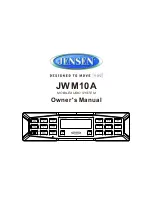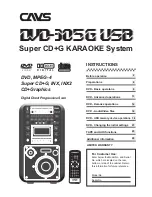
• FEEDBACK:
When the
FEEDBACK
LED is illuminated,
the feedback amount is indicated. This amount can be set
in the range of 0–9.9. Note that 1.1 denotes 110%.
Since a feedback higher than 100% can be set, you can
create a feedback effect that increases the volume of the
delay sound at each repeat. Excessive feedback settings
can damage your speakers. Be careful of the volume.
When a feedback value higher than 91% is set, a 50-Hz
high-pass filter is automatically activated.
• OUT:
When the
OUT
LED is illuminated, the output level
is indicated. When the display shows 70, the unit is set to
the unity level at which the signal is output at the same
level as the received level. When set to 99, a +3-dB boost
can be attained. Variable range is 10–99.
r
FILTER/MODULATION Section
• LPF:
When the
LPF
(low-pass filter) LED is illuminated,
the LPF frequency is indicated.
The unit for the displayed value is kHz. If, for example,
16 is shown, then a 16-kHz low-pass filter is activated
(frequencies higher than 16 kHz will be cut).
A low-pass filter is highly useful to attain a warm delay
sound like that obtained with a tape echo machine.
• HPF:
When the
HPF
(high-pass filter) LED is illuminated,
the HPF frequency is indicated.
The unit for the displayed value is 10 Hz. If, for example,
20 is shown, then a 200-Hz high-pass filter is activated
(frequencies lower than 200 Hz will be cut).
A high-pass filter is highly useful when creating a delay
sound for solo playing. If the delay sound contains a lot
of low frequency components, your playing in a lower
register can become hard to hear. By applying this filter
to the low frequencies, you can have settings that will not
loose the edges of phrases.
• RATE:
When the
RATE
LED is illuminated, the rate
of the modulation is indicated. By increasing the rate
value, the modulation speed is increased. Variable range
is 0–99. Usually the waveform used when applying a
modulation starts from the positive (+) side. You can flip
this waveform so that it starts from the negative (–) side:
press the
DEC/–
button when you are setting a value so
that the
DOWN
dot illuminates.
• DEPTH:
When the
DEPTH
LED is illuminated, the depth
of the modulation is indicated. By increasing the set depth
value, the modulation is applied more deeply (strongly).
t
SUBDIVISION/OFFSET Section
• SUBDIVISION:
When the
SUBDIVISION
LED is
illuminated, the set subdivision value is indicated. Delay
time can be set by counting the reference tempo with
quarter notes.
The default value is quarter note (crotchet). You can select
from: Whole note (Semibreve), Half note (Minim), Dotted
Quarter note, Triplet in four, Quarter note (Crochet), Dotted
Eighth note, Triplet in two, Eighth note (Quaver), Triplet in
one, and Sixteenth note (Demiquaver). When you select
dotted quarter or eighth note, the
DOTTED
dot LED in the
first digit will illuminate.
* When the time display is set to “msec”, the delay time
is automatically calculated and the display will change
based on the setting. If the time display is set to “BPM”,
then the display will not change.
• OFFSET:
Delay time can be offset in the range of ±99
ms for each preset.
A shorter delay time can result in a speedy, vigorous delay
sound and a longer delay time can make a spacious and
expressive delay sound.
y
Parameter Edit Section
• INC/+:
Increases the parameter value.
• DEC/–:
Decreases the parameter value.
• STORE:
Press this button to store the setting.
• ENTER:
Used to confirm the parameter or to store the
setting.
u
BPM ANALYZER & MIC Section
• BPM ANALYZER:
The on/off switch for the BPM
Analyzer function. When the function is active, the LED
illuminates. The tempo of the actual performance is
analyzed in realtime within the ±20% of the tempo (BPM)
information entered via the TAP footswitch and the BPM
is automatically adjusted in about five- to ten-second
intervals to change the delay time.
Note 1: If the BPM of the tap-entered tempo information
differs more than ±20% from that of the actual
performance, then there is no automatic adjustment of
delay time.
Note 2: The realtime BPM analyzer may not be able to
recognize BPM for performances with irregular meters,
performances by orchestra or piano, etc.
• MIC:
This microphone is used to pick up the sound of
performance for BPM analysis.
i
Other Features
• REC & REPEAT:
The Rec & Repeat function records
and repeats the incoming signal. This function is activated
when the LED illuminates. Connect a footswitch to
the
HOLD
terminal on the rear panel and use it as the
footswitch for Rec function. The preset delay effect will
be applied to both the recorded repeated sound and the
sound played along with the repeated sound. You can
record the input for 20 seconds. (Only one phrase can be
recorded; recording cannot be layered.)
This function can be set for each preset.
How to Use Rec & Repeat Function
1. Press and hold down the switch (momentary/unlatch
type) connected to the
HOLD (REC)
terminal for
about three seconds. (This switch is called the “REC”
switch.)
2. The
TIME
display flashes [
REC
].
3. Recording will start by pressing the
REC
switch. Start
performance in sync with the timing.
4. To start the repeat playback of the just recorded
sound, press the
TAP-PLAY
switch after recording.
This starts the repeat playback instantly.
5. By pressing the
TAP-PLAY
switch during a repeat
playback, the playback starts from the beginning of
the recording.
6. Press the
ON/OFF-STOP
switch to stop recording or
playback.
7. To exit Rec & Repeat mode and return to usual mode,
press and hold the
REC
switch again for about three
seconds.
NOTE:
The Hold function does not function if the Rec &
Repeat function is turned on.
• TRAIL:
This function switches to the new preset while
leaving the delay sound. This allows you to attain a natural
effect switching. This function can be set for each preset.
• DELAY PHASE:
Switch used to invert the phase of
the delay sound. The LED illuminates when the phase of
the delay sound is inverted. This feature can be set for
each preset.
o
ON/OFF-STOP / DOWN Footswitch
Switch to turn on/off the delay effects. When set to ON,
the LED above the switch illuminates. When the Rec &
Repeat function is active, this switch acts as a STOP
switch to stop recording or playback.
1)
TAP-PLAY / hold (PS SEL>PS1/PS2) / UP Footswitch
This footswitch is used to enter the tap tempo. The entered
tempo is counted with quarter notes (crotchets) and this
timing is used to calculate the BPM value. This footswitch
is use as a PLAY switch when the Rec & Repeat function
is active.
By holding down this footswitch, you can recall Preset 1
and Preset 2 repeatedly. For example, you can set a short
delay in Preset 1 and a long delay in Preset 2 and switch
between them easily.
REC & REPEAT FLOWCHART
Connect an unlatch (momentary) type footswitch
to the
HOLD (REC)
terminal on the rear panel.
HOLD
(REC)
switch
HOLD
(REC)
switch
TAP-PLAY
switch
ON/OFF-STOP
switch
ON/OFF-STOP
switch
HOLD
(REC)
switch
HOLD
(REC)
switch
Press & Hold down the
HOLD (REC)
switch for 3
seconds to put the machine
in Rec Standby mode.
[REC]
flashes.
Press & Hold down the
HOLD (REC)
switch for 3
seconds to exit from Rec
Standby mode to usual
mode.
Press the
HOLD (REC)
switch to start recording.
[REC]
illuminates steadily.
Press the
HOLD (REC)
switch to start recording.
[REC]
illuminates.
Press the
TAP-PLAY
switch
to stop recording and start
playback.
[PLAY]
illuminates.
Press the
ON/OFF-STOP
switch to stop recording.
[STOP]
illuminates.
Press the
ON/OFF-STOP
switch to stop playback.
[STOP]
illuminates.
Содержание FT-1Y
Страница 1: ...OWNER S MANUAL Ver 1 0...
























